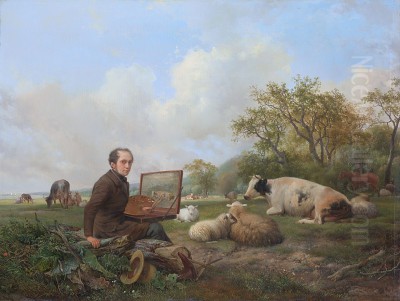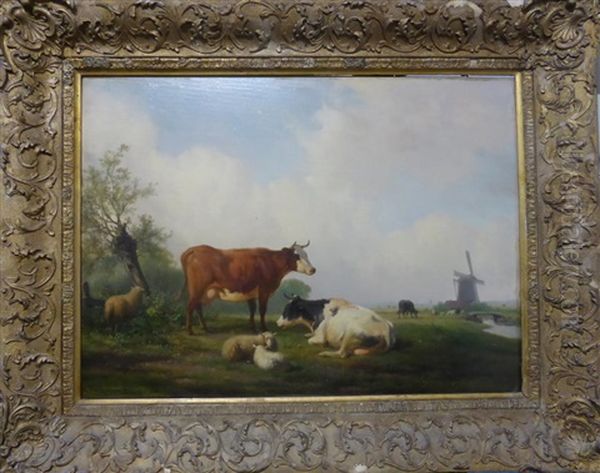
Hendrikus van de Sande Bakhuyzen (1795-1860) stands as a significant figure in the landscape of 19th-century Dutch art. Born and primarily active in The Hague, he became one of the most respected painters of the Dutch Romantic period, particularly celebrated for his meticulously rendered pastoral scenes often populated with cattle. His work forms a crucial link between the traditions of the 17th-century Dutch Golden Age masters and the later innovations of the Hague School, influencing a generation of artists through both his paintings and his dedicated teaching.
Early Life and Artistic Formation
Hendrikus van de Sande Bakhuyzen was born in The Hague on September 2, 1795. His family name, Bakhuyzen, might evoke associations with the famous 17th-century marine painter Ludolf Backhuysen (or Bakhuizen), but Hendrikus belonged to a different lineage and focused on entirely different subject matter. He hailed from a family that would become deeply embedded in the arts; his son Julius and daughter Gerardine would also pursue successful careers as painters.
His initial artistic training likely came from J. Heymans, followed by studies under Simon Andreas Krausz at the Hague Drawing Academy (Haagsche Teekenacademie). This institution, founded in the late 17th century, provided a formal grounding in drawing and the principles of art. From early on, Bakhuyzen demonstrated a remarkable talent for detailed observation and precise rendering, qualities that would define his mature style.
The artistic environment of the early 19th century in the Netherlands was one of rediscovery and reinterpretation of the nation's glorious artistic past. Painters looked back with reverence to the Golden Age masters of the 17th century, particularly the landscape and animal painters. This historical consciousness deeply informed Bakhuyzen's development.
The Romantic Landscape: Style and Subject
Hendrikus van de Sande Bakhuyzen specialized in landscape painting, embracing the Romantic sensibility prevalent across Europe but filtering it through a distinctly Dutch lens. Unlike the dramatic, often turbulent scenes favoured by some Romantics, Bakhuyzen's vision was typically one of pastoral tranquility and idealized nature. His landscapes are characterized by their careful composition, meticulous detail, and serene atmosphere.

He drew significant inspiration from 17th-century Dutch masters, most notably Paulus Potter, who was renowned for his paintings of cattle in sunlit fields. Bakhuyzen adopted Potter's focus on livestock, particularly cows, sheep, and horses, integrating them seamlessly into his landscapes. These animals were not mere accessories but central elements, rendered with anatomical accuracy and a sensitivity to their placid nature. His skill in depicting cattle earned him considerable acclaim and became a hallmark of his work, leading to the affectionate term "beestjesstukken" (little animal pieces) being associated with his oeuvre.
Bakhuyzen's technique involved careful layering of glazes to achieve depth and luminosity. He paid close attention to the effects of light and atmosphere, often depicting scenes bathed in the soft, warm light of early morning or late afternoon. Skies are typically rendered with delicate cloud formations, contributing to the overall sense of peace and harmony. While idealized, his landscapes were rooted in careful observation of the Dutch countryside, particularly the meadows, woods, and waterways around The Hague, as well as areas like Gelderland and Drenthe, where he sketched during summer trips.
His compositions are balanced and thoughtfully constructed, often employing traditional framing devices like trees or riverbanks to lead the viewer's eye into the scene. The level of detail is remarkable, extending from the textures of tree bark and foliage to the reflections in water and the coats of the animals. This precision reflects his academic training and distinguishes his work from the looser, more atmospheric approach that would later characterize the Hague School.
Representative Works
While specific titles can vary or refer to similar compositions, works representative of Hendrikus van de Sande Bakhuyzen's style often feature descriptive titles indicating their content. A prime example is Landscape with Cattle, housed in the Rijksmuseum, Amsterdam. This painting showcases his typical subject matter: a serene meadow landscape under a luminous sky, with meticulously rendered cattle grazing peacefully near a body of water. Other works frequently depict similar scenes: Cattle in a Meadow near the Woods, Landscape near Oosterbeek, or Driving Cattle Home at Sunset. These paintings consistently demonstrate his mastery of detail, light, and the integration of animals into an idealized natural setting.
Connections and Collaborations
Hendrikus van de Sande Bakhuyzen was an active member of the artistic community in The Hague and beyond. He maintained a close friendship and professional relationship with Andreas Schelfhout (1787-1870), another leading Dutch Romantic landscape painter. Schelfhout was particularly known for his winter scenes and seascapes, but also painted summer landscapes. The two artists occasionally collaborated on paintings, a practice not uncommon at the time, where one artist might paint the landscape and another the figures or animals, although both Bakhuyzen and Schelfhout were highly skilled in all aspects. Their styles, while distinct, shared a common grounding in detailed observation and Romantic sentiment.
Bakhuyzen's work should also be seen in the context of other prominent Dutch Romantic landscape painters of his generation, such as Barend Cornelis Koekkoek (1803-1862), who achieved international fame for his majestic forest and river scenes, often with a more dramatic flair than Bakhuyzen's typically tranquil compositions. While Koekkoek often depicted grander, sometimes imaginary or German-inspired landscapes, Bakhuyzen remained more focused on the specific character of the Dutch countryside.
He was a member of the Royal Academy of Art in Amsterdam from 1822 and also belonged to the Arti et Amicitiae society in Amsterdam, participating regularly in exhibitions like the Exhibition of Living Masters (Tentoonstelling van Levende Meesters). These affiliations placed him at the heart of the Dutch art world of his time.
A Respected Teacher and Lasting Influence
Beyond his own artistic production, Hendrikus van de Sande Bakhuyzen played a crucial role as an educator, influencing a significant number of younger artists. He ran a busy studio and was known as a dedicated and meticulous teacher. His emphasis on careful drawing, observation from nature, and technical proficiency provided a strong foundation for his pupils.
Among his most notable students were several artists who would become key figures in the Hague School, a movement that emerged in the latter half of the 19th century and moved towards a more realistic, atmospheric, and tonally subdued style of landscape painting. These include Willem Roelofs (1822-1897) and Jan Hendrik Weissenbruch (1824-1903). Although these artists ultimately developed styles distinct from their teacher's precise Romanticism, the grounding they received from Bakhuyzen in observing nature and mastering technique was invaluable.
Other students included Hubertus van Hove (1814-1865), known for his interiors and townscapes; Pieter Stortenbeker (1828-1898), who also specialized in landscapes with cattle, closely following his master's style initially; Francois Pieter ter Meulen (1843-1927), who became known for his sheep paintings in the Hague School manner; and Marie Bilders-van Bosse (1837-1900), one of the few prominent female artists associated with the Hague School milieu.
His artistic legacy also continued directly within his own family. His son, Julius Jacobus van de Sande Bakhuyzen (1835-1925), became a respected painter in his own right, associated with the Hague School. While influenced by his father, Julius developed a somewhat looser style, often painting en plein air (outdoors), reflecting the influence of French Barbizon School painters like Théodore Rousseau and Charles-François Daubigny. Hendrikus's daughter, Gerardine Jacoba van de Sande Bakhuyzen (1826-1895), gained recognition as a talented painter of still lifes, particularly flowers. The Bakhuyzen studio was clearly a hub of artistic activity and learning.
The influence Bakhuyzen wielded extended beyond his direct pupils. His success and the popularity of his idealized pastoral scenes helped sustain the tradition of Dutch landscape painting and set a standard of technical excellence. Even as the Hague School artists moved towards capturing mood and atmosphere over precise detail, the legacy of careful observation inherited from painters like Bakhuyzen remained an undercurrent. Figures like Anton Mauve (1838-1888) or Jozef Israëls (1824-1911), leading lights of the Hague School, represented the next evolution, but Bakhuyzen's generation provided the essential bridge from earlier traditions.
Recognition and Art Historical Position
During his lifetime, Hendrikus van de Sande Bakhuyzen enjoyed considerable success and recognition. His paintings were sought after by collectors both in the Netherlands and abroad. His meticulous technique, appealing subject matter, and the recognizable quality of his work ensured a steady market. His participation in major exhibitions and his membership in prestigious art institutions solidified his reputation as one of the leading painters of his day.
In art history, he is firmly positioned as a key exponent of Dutch Romanticism. He successfully adapted the legacy of the 17th-century masters, particularly Paulus Potter, to the sensibilities of the 19th century. His focus on the native Dutch landscape, rendered with precision yet imbued with a peaceful, idealized quality, resonated with contemporary tastes that valued both national heritage and Romantic sentiment.
While later movements like the Hague School would pursue different aesthetic goals, emphasizing atmosphere, tonality, and the effects of light in a broader, often more melancholic manner, Bakhuyzen's contribution remains significant. He upheld a high standard of craftsmanship and kept the tradition of landscape and animal painting vital. Furthermore, his role as a teacher directly shaped the artists who would define the next major phase of Dutch art. He represents a point of stability and excellence, a master of his chosen genre whose influence extended well beyond his own canvases.
Conclusion
Hendrikus van de Sande Bakhuyzen occupies an important place in the narrative of 19th-century Dutch art. As a master of the Romantic landscape, he captured the tranquil beauty of the Dutch countryside with unparalleled precision and sensitivity, specializing in the depiction of cattle within serene pastoral settings. Deeply influenced by the Golden Age masters yet firmly rooted in his own time, he created works that were both technically accomplished and emotionally resonant. Through his prolific output and his dedicated teaching, he not only achieved personal renown but also significantly influenced the course of Dutch painting, nurturing talents like Willem Roelofs and Jan Weissenbruch who would lead the subsequent Hague School movement. His legacy endures in his beautifully crafted paintings and in the artistic lineage he helped to shape, securing his status as a cornerstone of Dutch Romantic art.